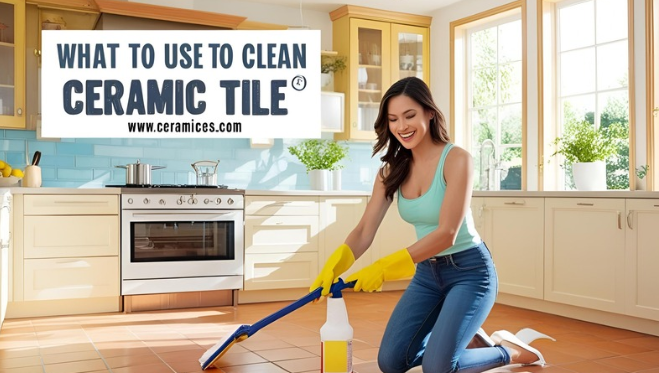Ceramic tile floors are a popular choice for homes and businesses due to their durability, aesthetic appeal, and ease of maintenance. However, keeping them clean and looking their best requires the right tools and techniques. So, what to use to clean ceramic tile floors? In this article, we’ll explore the best cleaning solutions, tools, and methods for maintaining ceramic tile floors. We’ll also address frequently asked questions to help you achieve a spotless and long-lasting finish. Whether you’re dealing with everyday dirt or stubborn stains, this guide will provide the knowledge you need to keep your ceramic tile floors in pristine condition.
Why is Proper Cleaning Important for Ceramic Tile Floors?
Ceramic tile floors are durable, but improper cleaning can lead to:
- Dull or discolored tiles
- Damaged grout
- Stubborn stains
- Reduced lifespan of the tiles
Using the right cleaning products and techniques ensures that your ceramic tile floors remain beautiful and functional for years to come.
Best Cleaning Solutions for Ceramic Tile Floors

The cleaning solution you use plays a crucial role in maintaining ceramic tile floors. Here are the best options:
1. Mild Detergent and Water
A mixture of mild dish soap and warm water is one of the safest and most effective ways to clean ceramic tile floors.
How to Use:
- Mix a few drops of mild dish soap with a bucket of warm water.
- Use a mop or soft cloth to clean the floor, avoiding excessive water.
- Rinse with clean water and dry with a microfiber cloth.
2. Vinegar and Water Solution
Vinegar is a natural cleaner that can remove dirt and grime without damaging ceramic tiles.
How to Use:
- Mix equal parts white vinegar and water in a spray bottle.
- Spray the solution onto the tiles and scrub with a soft brush or mop.
- Rinse with water and dry thoroughly.
3. Baking Soda Paste
Baking soda is a gentle abrasive that can remove tough stains without scratching ceramic tiles.
How to Use:
- Mix baking soda with water to form a thick paste.
- Apply the paste to the stained area and scrub gently with a soft brush.
- Rinse with water and dry.
4. Commercial Tile Cleaners
There are many commercial tile cleaners specifically designed for ceramic tiles. Look for pH-neutral or non-abrasive formulas.
How to Use:
- Follow the manufacturer’s instructions for dilution and application.
- Use a mop or soft cloth to clean the floor.
- Rinse with water if required and dry.
5. Hydrogen Peroxide
Hydrogen peroxide is effective for removing mold, mildew, and stubborn stains from ceramic tiles and grout.
How to Use:
- Apply hydrogen peroxide directly to the stained area.
- Let it sit for 10-15 minutes, then scrub with a soft brush.
- Rinse with water and dry.
Best Tools for Cleaning Ceramic Tile Floors
Using the right tools is just as important as choosing the right cleaning solution. Here are the best tools for cleaning ceramic tile floors:
1. Microfiber Mop
A microfiber mop is gentle on ceramic tiles and effectively picks up dirt and dust without scratching the surface.
2. Soft-Bristle Brush
A soft-bristle brush is ideal for scrubbing grout lines and removing stubborn stains without damaging the tiles.
3. Sponge Mop
A sponge mop is great for applying cleaning solutions and rinsing the floor with water.
4. Steam Mop
A steam mop uses hot steam to sanitize and clean ceramic tiles without the need for chemicals.
5. Vacuum Cleaner
A vacuum cleaner with a soft brush attachment can remove loose dirt and debris before mopping.
Step-by-Step Guide to Cleaning Ceramic Tile Floors

Follow these steps to achieve a clean and shiny ceramic tile floor:
1. Remove Loose Dirt
- Use a vacuum cleaner or broom to remove loose dirt, dust, and debris from the floor.
2. Prepare the Cleaning Solution
- Choose a cleaning solution based on your needs (mild detergent, vinegar, baking soda, etc.).
- Mix the solution according to the instructions.
3. Apply the Cleaning Solution
- Use a mop or spray bottle to apply the cleaning solution to the floor.
- Work in small sections to ensure even coverage.
4. Scrub the Tiles and Grout
- Use a soft-bristle brush to scrub the tiles and grout lines, focusing on stained or dirty areas.
5. Rinse the Floor
- Rinse the floor with clean water to remove any residue from the cleaning solution.
- Use a sponge mop or clean cloth for rinsing.
6. Dry the Floor
- Dry the floor with a microfiber cloth or allow it to air dry.
- Avoid walking on the floor until it is completely dry.
Tips for Maintaining Ceramic Tile Floors
To keep your ceramic tile floors looking their best, follow these maintenance tips:
1. Sweep or Vacuum Regularly
- Remove loose dirt and debris daily to prevent scratches and buildup.
2. Clean Spills Immediately
- Wipe up spills as soon as they occur to prevent stains and damage to the grout.
3. Use Doormats
- Place doormats at entrances to reduce the amount of dirt and moisture tracked onto the floor.
4. Avoid Harsh Chemicals
- Avoid using acidic or abrasive cleaners, as they can damage the tiles and grout.
5. Seal the Grout
- Apply a grout sealer every 6-12 months to protect the grout from stains and moisture.
6. Use Furniture Pads
- Place felt pads under furniture legs to prevent scratches and scuffs on the tiles.
FAQs About Cleaning Ceramic Tile Floors
1. What to use to clean ceramic tile floors?
Use mild detergent and water, vinegar and water solution, baking soda paste, or commercial tile cleaners.
2. Can I use vinegar to clean ceramic tile floors?
Yes, vinegar is a safe and effective natural cleaner for ceramic tiles. Mix it with water for best results.
3. How do I remove tough stains from ceramic tiles?
Use a baking soda paste or hydrogen peroxide to scrub away tough stains gently.
4. Can I use a steam mop on ceramic tile floors?
Yes, steam mops are safe for ceramic tiles and provide a chemical-free cleaning option.
5. How often should I clean ceramic tile floors?
Sweep or vacuum daily and mop weekly to keep ceramic tile floors clean and well-maintained.
6. What should I avoid when cleaning ceramic tile floors?
Avoid using acidic or abrasive cleaners, excessive water, and harsh scrubbers that can damage the tiles and grout.
7. How do I clean grout lines?
Use a soft-bristle brush and a cleaning solution like baking soda paste or hydrogen peroxide to scrub grout lines.
8. Can I use bleach on ceramic tile floors?
Bleach can be used sparingly for disinfecting, but it may discolor grout over time. Rinse thoroughly after use.
9. How do I prevent scratches on ceramic tile floors?
Use doormats, furniture pads, and soft cleaning tools to prevent scratches and scuffs.
10. Should I seal my ceramic tile floors?
While ceramic tiles themselves do not need sealing, applying a grout sealer every 6-12 months protects the grout from stains and moisture.
Conclusion
So, what to use to clean ceramic tile floors? The key is to use gentle, non-abrasive cleaning solutions like mild detergent, vinegar, or baking soda, along with the right tools like microfiber mops and soft-bristle brushes. Regular maintenance, such as sweeping, mopping, and sealing grout, will keep your ceramic tile floors looking pristine and extend their lifespan.
By following the tips and techniques outlined in this guide, you can easily maintain the beauty and functionality of your ceramic tile floors. Whether you’re dealing with everyday dirt or stubborn stains, the right approach will ensure your floors remain spotless and durable for years to come.
With the knowledge and tools from this guide, you’ll be well-equipped to tackle any cleaning challenge and enjoy the timeless appeal of ceramic tile floors in your home or business. Happy cleaning!